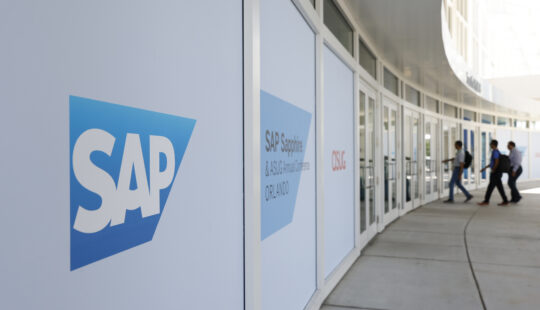WALLDORF, Germany — After an initial review of its first quarter 2020 performance, SAP SE (NYSE: SAP) today announced its preliminary financial results for the first quarter ended March 31, 2020.
- IFRS Cloud Revenue Up 29%; Non-IFRS Cloud Revenue Up 27%
- Software Licenses Revenue Down 31%
- Total Revenue Up 7%
- IFRS Operating Profit Up More Than 100%; Non-IFRS Operating Profit Up 1%
- 2020 Outlook Updated to Reflect Estimated Impact of COVID-19
“As the world navigates the COVID-19 pandemic, SAP has remained focused on our employees, customers, and communities. To support them, we made our vast business networks and technology available for companies to find new sources of supply and manage demand, understand and act on sentiment across value chains that went virtual overnight, and support learning efforts at scale. Our customers will continue to rely on us to listen and engage with their employees in new ways, manage their supply chains, and connect with their customers in a virtual world where sentiment will become a leading indicator.”
— Jennifer Morgan and Christian Klein, Co-CEOs
“Our multi-year emphasis on building a strong base of more predictable revenue has made SAP more resilient than ever. Combined with an even more prudent expense management and a continued focus on innovation we will weather the COVID-19 crisis and emerge stronger than before as we have done in past downturns. Our updated guidance demonstrates that even in this challenging environment SAP remains healthy and stable.”
— Luka Mucic, CFO
First Quarter Business Update
All 2020 figures in this release are approximate due to the preliminary nature of the announcement and the high uncertainty associated with the COVID-19 crisis.
Business activity in the first two months of the quarter was healthy. As the impact of the COVID-19 crisis rapidly intensified towards the end of the quarter, a significant amount of new business was postponed. This is reflected, in particular, in the significant year over year decrease in software licenses revenue.
SAP has quickly responded to the new environment by adopting a virtual sales and remote implementation strategy. To protect profitability SAP is slowing hiring and reducing discretionary spend in addition to natural savings e.g. from lower travel and virtualized events.
SAP remains committed to its long-term strategy and prospects and is continuing to invest in innovation. SAP expects to emerge from the COVID-19 crisis in an even stronger competitive position than before.
Financial Performance
In the first quarter, cloud revenue grew 29% year over year to €2.01 billion (IFRS), up 27% to €2.01 billion (non-IFRS) and 25% (non-IFRS at constant currencies). Software licenses revenue was down 31% year over year to €0.45 billion (IFRS and non-IFRS) and 31% (non-IFRS at constant currencies). Cloud and software revenue grew 7% year over year to €5.40 billion (IFRS), up 6% to €5.40 billion (non-IFRS) and 5% (non-IFRS at constant currencies). Total revenue grew 7% year over year to €6.52 billion (IFRS), up 7% to €6.52 billion (non-IFRS) and 5% (non-IFRS at constant currencies).
The share of more predictable revenue grew by approximately 4 percentage points year over year to approximately 76% in the first quarter.
As expected, the IFRS operating profit in the first quarter increased significantly primarily due to a significantly lower impact from both restructuring expenses and share-based compensation expenses. Operating profit increased more than 100% year over year to €1.21 billion (IFRS) and up 1% to €1.48 billion (non-IFRS) and down 1% (non-IFRS at constant currencies).
In the first quarter, SAP incurred a cost of approximately €36 million in relation to the cancellation of its in-person annual SAPPHIRE NOW and other customer events. Absent the cancellations, these expenses would have been recognized in the later quarters for which the events were originally scheduled.
Operating margin increased 20.7 percentage points year over year to 18.5% (IFRS) and declined 1.3 percent-age points year over year to 22.7% (non-IFRS) and 1.3 percentage points to 22.6% (non-IFRS at constant currencies).
This article first appeared on the SAP News Center.



